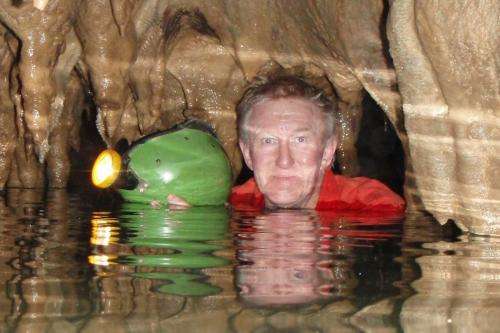Demise of last ice age encoded in tropical stalagmites

Hidden deep underground in Indonesian caves, the missing link in the demise of the last ice age has been uncovered in stalagmites, which have provided a 31,000 year-long record of Australasian monsoon activity.
"Stalagmites are the ice core records of the tropics," explains Dr Linda Ayliffe from the Research School of Earth Sciences (RSES).
"They are the only natural climate archive with the length, resolution and age-control required to document the response of the Australasian monsoon to abrupt climate change over tens of thousands of years."
The global monsoon system is considered to be an important climate link between the northern and southern hemispheres during the deglaciation of the last ice age. Until now, direct evidence for the southern half of the vast Australasian monsoon has been lacking.
Dr Ayliffe and Associate Professor Mike Gagan of RSES, along with colleagues at the Indonesian Institute of Sciences, the University of Queensland, the University of Melbourne, and William Paterson University analysed the geochemical composition of stalagmites in Liang Luar cave on the island of Flores, Indonesia.
Stalagmites, like those found in Liang Luar, are formed when rain soaks through limestone causing mineral-rich water to drip into the cave, forming towers of calcium carbonate. The research team was able to tell the precise time and amount of rainfall in the area by analysing variants of oxygen known as isotopes, found in this calcium carbonate.
"We explored the 1700 metre length of Liang Luar cave in 2006 and devoted most of the 2007 expedition to the drilling of exploratory mini-cores to date the stalagmites," says Associate Professor Gagan.
"It wasn't until 2009 that we had finally identified stalagmites of exactly the right age to complete the record."
Comparing this southern hemispheric rainfall record to northern hemispheric records from China revealed a clear interhemispheric 'rainfall seesaw' pattern across Australasia – when it was dry in Indonesia, it was wet in China, and vice versa.
"The rainfall seesaw is a robust signal in climate models, but this is the first time we've had detailed and precisely dated records showing its widespread impact across Australasia," says Dr Ayliffe.
"It's a satisfying result because it contributes to a unifying hypothesis that explains how the hemispheres are coupled during ice age terminations."
"Our findings are also relevant to understanding future rainfall patterns in the heavily populated Australasian monsoon region," says Dr Gagan.
"For example, if the Asian monsoon were to strengthen due to greenhouse warming in the 21st century, as suggested by climate models, then Indonesia will probably become drier. Any decline in agricultural production related to a drier tropics would clearly be challenging for Indonesia."
Provided by Australian National University




















